5 | On the Origins and Race of the Jews
Arthur Ruppin
“The Composition of the Jews in Palestine,” chapter 1 of Soziologie der Juden (Berlin: Jüdischer Verlag, 1930), vol. 1.
The work’s title page informs readers that the material in the two-volume Soziologie der Juden (Sociology of the Jews) derives from lectures delivered at Hebrew University in Jerusalem. Arthur Ruppin (1876–1943) was born in Posen, then a district of Prussia. He studied law and national economy at the Universities of Berlin and Halle. After a short stint as a lawyer, in 1904 he accepted the position of director of the newly founded Bureau of Jewish Statistics in Berlin. In this capacity, Ruppin was responsible for the publication of the Zeitschrift für Demographie und Statistik der Juden (The journal of the demography and statistics of the Jews), which he edited with his assistant Jakob Thon. Ruppin was keenly interested in the question of the Jews as a race, and the theme appears in almost all of his most important writings. His most influential work was Die Juden der Gegenwart (The Jews of today), published first in 1904 and then in a revised edition in 1911. See the entry in the Encyclopedia Judaica, 14:430–31.
1. THE THREE VOLK ELEMENTS:
CANAANITE, BEDOUIN, PHILISTINE
The Jewish people emerged during the fourteenth and fifteenth centuries before Christ, when Palestine was controlled by Egypt, and its cities ruled by the nomarchs of the pharaoh. During this time, according to the biblical account, a nomadic people—the “sons of Jacob”—came from the desert, advancing into the eastern part of Jordan, and then went on to western Jordan. They were perhaps identical to the “Chabiri” (= Hebrews?) who had invaded from the East, mentioned in fourteenth-century reports made to the pharaoh by Palestinian landlords, and discovered at Tel-el-Amarna. These sons of Jacob subjugated the inhabitants of Palestine, the Canaanites or Amorites.42 In the ensuing period, the sons of Jacob gradually amalgamated with the other inhabitants of the land and became one Volk, which has commonly been named the Israelites, the sons of Israel. Later, the Israelites engaged in fierce battles with the Philistines. The Philistines had launched an attack by sea against the Egyptians from their dwelling place in Caphtor (Crete) in the year 1196 BC. They were, however, fended of by Ramses III, and then settled on the Mediterranean coast of Palestine—giving it its name (Philistina = Palestine). The struggles between these two peoples, which lasted for centuries, ended with the Philistines losing their ethnic unity and being amalgamated into the Israelite Volk.
Thus, there are three Volk elements out of which the Jewish people in Palestine were composed: the sons of Jacob, the Canaanites, and the Philistines. The Philistines belong—like the Greeks of antiquity—to the Aegean cultural circle, and brought the highly evolved Cretan culture (for example, iron tools and chariots of war) to Palestine. Considering that Palestine was a small land without permanent natural borders, and that for thousands of years it had been a point of entry (a bridge) for the Aramaeans living to the north and for the Bedouins living to the east and to the south, the Canaanites have to be seen as a cross between Aramaeans and Bedouins. The same goes for the sons of Jacob. The Bible reports that the heros eponymos [founder of a people or nation] of the Israelites, Abraham, came from Haran in Aram-Naharajim43 and identifies Jacob explicitly as an Aramaean (Deuteronomy 26:5). On the other hand, it appears that before their entry into Palestine, the sons of Jacob united and intermixed with a Sinai Bedouin tribe, called the Kenites.
It has been claimed repeatedly that already in the second millennium before Christ, or even earlier, a blond Volk, belonging to a Northern European race, made its way from Northern Europe to Palestine during a period of great migration. Various researchers think they can prove, on the basis of visual depictions found in Egyptian tombs, that the Amorites were blond and blue-eyed, belonging to this Northern European race.44 However, this proof has turned out to be unsound, since the blond and blue colors on the visual images were not originally present, but emerged only as a result of the flaking of of a black top coat.45 It is, however, conceivable that in the seventh century BCE a part of the invading Scythian tribes, who are of Northern European descent and appear to have been related to today’s Kurds, had settled permanently in Palestine. The name Scythopolis, which Josephus gives for the city of Beisan in the upper Jordan Valley, indicates the settlement of Scythians in that place. Given such proximity of a population of a Northern European race, a sporadic influx of Northern European racial blood (Rassenblutes) into the Jewish Volk is generally conceivable. However, we know that although at all times half-nomadic peoples such as the Scythians displayed in their [campaigns of] conquest enormous force and speed, their actual numbers were nonetheless small. It is therefore not very likely that the Scythians influenced the Jews racially in any discernible way, especially since their dominance in Palestine lasted for such a short period.
2. THE THREE RACIAL COMPONENTS
Thus, the three elements of the Jewish people originate in northern Syria (Aramaeans), in the Arabic-Sinaitic steppes (Bedouins), and in Southern Europe (Philistines). The Völker who lived in these regions in antiquity were differentiated from one other on account of physical characteristics or, as we might also label them, racial traits.46
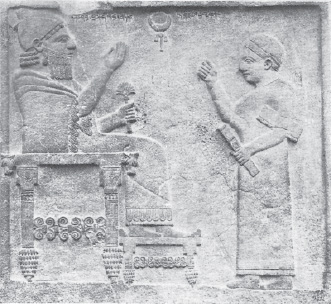
FIGURE 5.1
The first component, the Aramaeans, were political heirs to the ancient Hittite Empire, which reached the heights of its power around approximately 2000 BC, and whose sphere of influence reached from its capital Hattusas (today, Boghaszköi, near Angora) deep into the Near East and Syria, and eastward far beyond the Euphrates. When this empire started to decline, sometime around 1500 BC, a part of it was preserved under the rule of the Aramaeans in northern Syria, with Sendschirli47 (near Alexandrette) its capital; they remained an independent empire until the eighth century, an empire whose southern border, at the time of Solomon, reached Damascus. Judging from the stone monuments found in Sendschirli, the Aramaean type possessed a small, thickset stature, with short limbs; a thick, curved nose; a broad face; and broad skull (see plate 1 [fig. 5.1]). Even the excavations made by Baron von Oppenheim in the city of Tel-Halaf (east of the Euphrates), which was founded by Hittites, and inhabited by Aramaeans, show this same type (see plates 2 and 3 [figs. 5.2 and 5.3]). This type was rather preponderant throughout Syria and Assyria in the first pre-Christian millennium, just as the Aramaic language at this time dominated the entire region. When today’s anti-Semitic caricaturists portray Jews with thick, curved noses and short limbs, they are actually showing the Aramaean or the Aramaic component within contemporary Jewry.
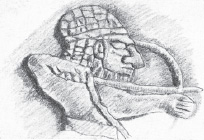
FIGURE 5.2
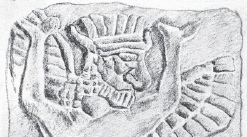
FIGURE 5.3
However, another type with such a prominent, protruding, very large, straight nose was to be found in Sendschirli (see plate 4 [fig. 5.4]). This type appears to have been dominant among the Hittites proper, in Asia Minor—as the findings in Boghaszköi demonstrate—remnants of which survived within the Aramaean Empire.
We are also taught about the appearance of the Aramaeans (North Syrians) by Egyptian representations; for example, a relief from the Temple of Ramses, in Medinet Habu, from approximately the year 1350 [BCE] which shows Ramses48 slaying his Syrian enemies (see plate 6 [fig. 5.6]); and a mural from the grave of Sebekhetep in Carnak from the fifteenth century [BCE], which shows a legation from Rethen (northern Syria) bringing tribute to the pharaoh (see plate 5 [fig. 5.5]).
In racial theory, the type that possesses the anatomical traits of the Aramaeans is designated as a “Near Eastern race” (vorderasiatische Rasse). The Assyrians also belong to this race, as the statues of Assyrian kings from the ninth and eighth centuries [BCE] show; these display with particular prominence the broad skull, the curved nose, and the massive physique (see plate 7 [fig. 5.7]). It is possible that the Assyrian sculptors have even exaggerated the curvature and thickness of the nose somewhat, since, like the “eagle’s nose” of the Prussian nobility, this was perhaps considered a mark of [social] distinction. The Jewish nose is different from the noble nose in that the noble nose proceeds straight out from the base of the nose, and the bend or curve begins only in the middle; the bridge of the nose is small. The Jewish nose, in contrast, displays the curvature throughout, from the base of the nose to the tip, which is usually thick. Interestingly, a small Egyptian statuette, from the period around 1700 BC,49 shows an Egyptian Hyksos king in the shape of a sphinx and with a characteristic “Jewish nose,” pinching the ears of an Egyptian [subject] kneeling in front of him.
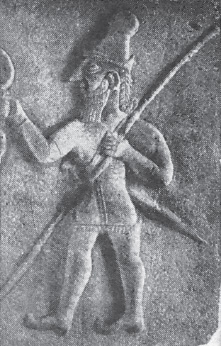
FIGURE 5.4
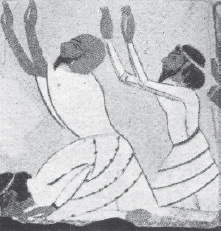
FIGURE 5.5
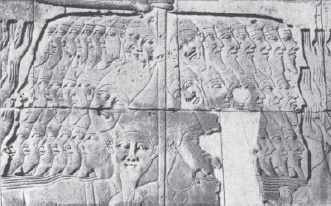
FIGURE 5.6
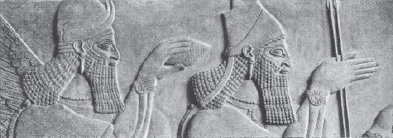
FIGURE 5.7
The second component of the Israelite Volk, the Bedouins, were the equivalent of today’s Bedouins of the Arabic steppes and the Sinai Peninsula. This is to say that they were of tall, slender stature, with long limbs; a narrow, straight nose; and narrow face; and were dolichocephalic. If one can say about the Aramaeans that their anatomies tend toward being thickset and large, so the Bedouins’ tend toward the long and slender. Eugen Fischer50—and, following him, H. Günther51—have recently introduced the designation of “Oriental” race into racial theory to designate those of this Bedouin type. Both scholars describe this race as closely akin to the Mediterranean race, which constitutes one of the three major branches of the white race. It is, therefore, arguably preferable to speak of this race as a variant (a racial branch) of the Mediterranean race, which in turn then would have to be divided into an Oriental (what Günther calls “eastern”) and Occidental (“western”) racial branch.
The Philistines, the third component, were of medium stature, with a rather narrow, straight nose and a narrow face, and were dolichocephalic. They constitute, along with the other Mediterranean peoples, the occidental (western) branch of the Mediterranean race. On Egyptian reliefs, they are represented with a head ornament of bird feathers (see plate 8 [fig. 5.8]). In contrast to the other Völker we have mentioned here, they did not wear beards.
All three components had white skin of various tones, from the fair white of the Aramaeans to the brownish white of the Philistines and the light brown of the Bedouins. They had dark hair and dark eyes.
The Jews of Palestine, who were constituted out of these three components, accordingly also displayed the bodily traits of these three components, either in a pure way or as a mixture of one with another. Redcliffe N. Salaman identifies the Philistines as a significant element in the racial composition of the Jews.52 He seeks to explain the frequent presence of the Greek type among today’s Jews, which he calls “Pseudo-Gentiles,” with reference to this impact [of the Philistines]. The question, however, is whether these Pseudo-Gentiles cannot just as well be traced back to the influence of the Oriental racial branch. Felix v. Luschan—who, in a multitude of works, has engaged with the issue of Jewish racial composition53—noticed, during his research trips through the Near East and northern Syria, the surprising similarity of the European Jews with many Near Eastern Armenians, with the Syrians of north Syria, and with the representations of the Hittite Aramaeans found on the reliefs of Sendschirli; he has concluded from this that the majority of Jews belongs to this Near Eastern–northern Syrian type, which he calls “Armenoid.” Other authors, in contrast, have found an unexpected similarity between the Jews and many Arabian (Bedouin) tribes. All three hypotheses have some truth to them. It is correct, as v. Luschan claims, that one finds individuals among today’s Jews who are similar to Syrians and Armenians. But it is also correct that among the Jews there exist individuals who display a great similarity to the Bedouins or Southern Europeans. Had v. Luschan made his research trips not in the Near East, but in Arabia or southern Italy, he would perhaps not have called attention to the similarity of the Jews with the Syrians or Armenians, but rather with the Arabian Bedouins or the Southern Europeans. Still, he did come closest to the truth as, in terms of percentage, the Near Eastern–north Syrian type is most strongly represented among today’s Central and Eastern European Jews.
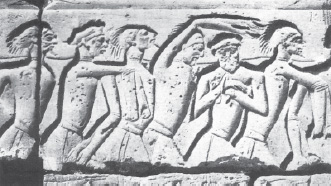
FIGURE 5.8
Beyond this, v. Luschan’s contribution has been to save the racial study of the Jews from the false path onto which linguistic researchers had led it. Heretofore, on account of the closeness of Hebrew to other Semitic languages, the Jews have been linked mainly with other Semitic-speaking peoples, and in particular with the purest representatives, the Bedouin Arabs; the most “authentic” Jews, in this view, are racially related to the Bedouins, and must be dolichocephalic. Von Luschan’s theory stood in direct opposition to this, since the “Armenoids” were decisively brachycephalic and both in antiquity and today belonged linguistically not to the Semites, but to the Indo-Germans. Only through this repudiation of the “Semite theory” was the way cleared for the first time for unbiased research into the Jewish race.54
When, after the destruction of the Kingdom of Judea (586 BC), a considerable portion of the Jews were led from Palestine to Babylonia, they maintained their religious particularity; yet they also absorbed converts from among the inhabitants of Babylonia and later from Persia, after the Persians conquered Babylon. However, this absorption of foreign blood should have had no influence, particularly on those Jews who, after seventy years of exile, returned to Palestine from Babylonia under the leadership of Ezra and Nehemiah. The relative short time of their stay in Babylonia, and the fact that it was precisely those pious, esteemed Jews who were careful to separate themselves from the pagans who returned to Palestine appears to justify the assertion that they returned from Babylonia with nearly the same racial traits that they had [originally] brought with them from Palestine. In Palestine itself, Ezra placed particular importance on keeping the pure families clear from intermixture with foreign elements, and made sure that foreign Volk elements would be purged. Therefore, at the time of the Second Temple’s destruction, the Jews in Palestine were racially constituted more or less as they had been at the time of the destruction of the First Temple. The absorption of the Bedouin Edomites that occurred in the meantime only led to a certain strengthening of the Bedouin element.
Following the results laid out above, the racial lineage (genealogical tree) of the Jews in Palestine at the time of the destruction of Jewish sovereignty is offered in [figure 5.9 above]. We avail ourselves of the most commonly used racial categories in anthropology. Let it be noted, to avoid any misunderstanding, that this racial classification—like every subdivision of race—is of course purely arbitrary. Instead of invoking skin color, hair and eye color, or the shape of the head, which are used here as the most important differentiating traits, one could employ any other anatomical characteristics as the foundation for such classification.55 The decisive factor employed by zoology to distinguish between species (the only absolute distinction that can be drawn to divide species and to maintain their idiosyncrasy)—namely, the capability of reproduction within the same species and the lack of that capability between different species—is of no use in distinguishing human races, since all humans are capable of reproducing with each other. The division of human beings into races and subraces also remains incomplete, insofar as the various races are connected to one another through crossings, leaving the racial identity of certain individuals in doubt. Nonetheless, the concept of races offers us a framework within which we may orient ourselves in regard to the chaos of individual differences by connecting that which is more closely related.
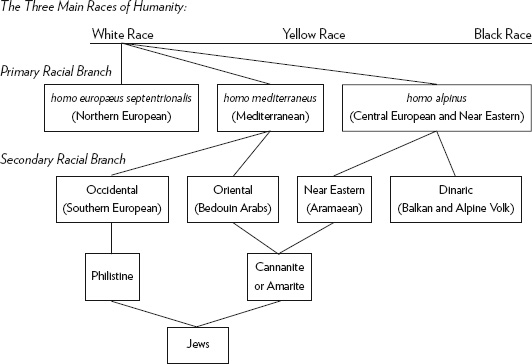
FIGURE 5.9
In racial theory, the most common racial division of humanity is that which classifies races into white, yellow, and black. The white race falls into the three branches of Northern European, Mediterranean, and Alpine. Within the Mediterranean branch, one finds the division between the Oriental (Bedouin) and Occidental branches; within the Alpine branch, the [subdivision between the] Near Eastern and the Dinaric. Within this terminological framework, the Jews are derived out of a mixture of the Near Eastern branch of the Alpine race with the Oriental and Occidental branches of the Mediterranean race.
Notes
42. According to Kautzsch (Das Alte Testament, Tübingen 1922, commentary on Genesis 15:19), the Canaanites and the Amorites are identical; in his view, the name “Amorite” was used by the Elohistic writer, and the name “Canaanite” by the Jawhist biblical source. According to Albright (Journal of the Palestine Oriental Society, vol. 8, p. 255, Jerusalem, 1928), the name “Canaanite” refers to the inhabitants of the coastal plains, the name “Amorite” to the inhabitants of the mountainous regions and the lands east of the Jordan. In any case, in terms of origins and language, the Canaanites and the Amorites are closely related.
43. The claim that Abraham came from Ur in the Chaldees is a later addition. Aram-Naharijm is not the land of the two rivers, Mesopotamia, but the Egyptian Narina or Naharin: northern Syria with Aleppo as the capital. (Kautzsch, et al., commentary on Genesis, 24:10).
44. Hans Günther, Rassenkunde der jüdischen Volkes (Munich, 1930), p. 56.
45. On this see the report of Max Burchardt, who shortly before the World War led a scientific expedition to Egypt to research the visual depictions of foreign peoples by Egyptians, in Zeitschrift für Demographie und Statistik der Juden, Berlin, 1927, p. 7.
46. Among the abundant literature on the Jewish race, see the following: R. Andree, Zur Volkskunde der Juden (Leipzig, 1881); Joseph Jacobs, “On the Racial Characteristics of Modern Jews,” in Journal of the Anthropological Institute, vol. 15, London, 1893; A. H. Sayce, The Races of the Old Testament (London, 1893); S. Weissenberg, “Die südrissischen Juden,” Archiv für Anthropologie, vol. 23, p. 348; Elkind, Evrei (Moscow, 1902), in Russian; M. J. Judt, Die Juden als Rasse (Warsaw, 1902; German edition Berlin, 1903); Maurice Fishberg, The Jews (New York, 1911); F. v. Luschan, The Early Inhabitants of Western Asia (London, 1911); I. Zollschan, Das Rassenproblem (Vienna, 1912); Fritz Kahn, Die Juden als Rasse und Kulturvolk (Berlin, 1920); F. v. Luschan, Völker, Rassen, Sprachen (Berlin, 1922); Wagenseil, Beiträge zur physischen Anthropologie der sefardischen Juden und zur jüdischen Rassenfrage (Stuttgart, 1922); S. Feist, Stammeskunde der Juden (Leipzig, 1925); H. Günther, Rassenkunde des jüdischen Volkes (Munich, 1930). Aside from Weissenberg and Wagenseil, who are mentioned above, anthropometric examinations of Jews have been conducted by Miss Dr. Lipieç (Warsaw), who published her results in numerous publications.
47. [Zincirli or Zinjirli, was an ancient city in what is today southeastern Turkey.]
48. [Ruppin is referring to the Temple of Ramses II. The date 1350 here, however, is not correct, as Ramses II reigned in the thirteenth century BCE.]
49. In the British Museum, 5th Egypt Room, Vitrine F, No. 54678.
50. Menschliche Erblichkeitslehre (Munich, 1927), vol. 1, p. 162.
51. Rassenkunde des jüdische Volkes (Munich, 1930), p. 68.
52. “Racial Origins of Jewish Types,” in Transactions of the Jewish Historical Society of England, vol. 9, London, 1920; in addition, “What Has Become of the Philistines?,” in Qua[r]terly Statement of Palestine Exploration Fund, vol. 57, p. 37, London, 1925.
53. See especially “Die Rassenstellung der Juden,” in Korresp.-Blatt der Anthropol. Gesell-schaft, 1892; in addition, Zeitschrift f. Demogr. und Statistik der Juden, 1905, p. 1, Berlin. [Felix von Luschan was one of Ruppin’s teachers at the University of Berlin.]
54. In an article on the racial status of the Jews, which v. Luschan wrote in 1905 at my request for the journal Zeitschrift für Demographie und Statistik der Juden, he declared: “It is as great a confusion of terms to speak of a Semitic race as to speak of a dolichocephalic language. The word ‘Semitic’ belongs to linguistics, not to the study of race.” Zeitschrift für Demographie und Statistik der Juden, 1905, p. 1.
55. Botany progressed from the arbitrary system of Linnaeus, which took into consideration only one trait (the filament), to a “natural” system that bases itself on the different structural forms (designs) of nature that are evident in plants, and seeks to make that the foundation of its classifications. Anthropology has still not been able to leave the arbitrary system of classification behind.